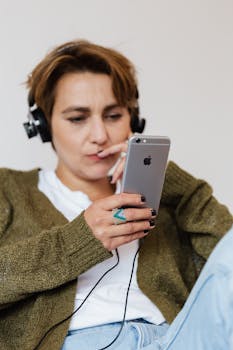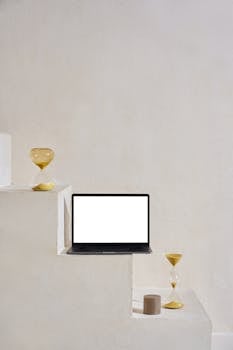Wellness
How to Improve Sleep Hygiene with Mobile Tools
Enhance your sleep hygiene with mobile tools that guide your routine, track patterns, and ease your bedtime wind-down. Discover actionable, expert tips for restful, consistent nights—ready to try tonight.
Advertisement
When you’re lying in bed, brain swirling and sleep escaping you, small habits can ripple into bigger results. Tiny digital cues nudging you toward better sleep hygiene can change the course of your night.
Good rest isn’t only about the timing of lights out. It’s crafted from consistent routines, mindful wind-down, and tracking that reveals subtle barriers to better sleep hygiene.
We’ll cover how mobile tools act as friendly assistants—helping you build nighttime habits, fine-tune routines, and address sleep hygiene with new confidence. Let’s discover what works tonight.
Customizable Sleep Routines Build Consistent Rest
Customizing your nightly shutdown with reminders and mini-routines leads to major sleep hygiene wins. Setting up app notifications guides you from screen to sleep.
You might add a prompt to lower the lights at 9:30, activate a soothing playlist, and check your hydration status. This sequence is repeatable, creating mental cues that tell your body it’s time for sleep.
Creating a Wind-Down Checklist
Open your app and build a five-step wind-down routine. For example: lower room lights, brush teeth, journal, breathing exercise, silence notifications. Swipe to tick off each task nightly for better sleep hygiene.
The act of ticking items gives structure. If you’re distracted, the next checklist item gently guides you back on track, helping you stick with the habit night after night.
Scripts help too. If you catch yourself thinking, “I’ll check one more email,” switch to the next wind-down task instead. Soon, this checklist feels second nature.
Syncing Reminders with Daily Life
An app reminder at 9:45 might signal you to dim the lights—not abruptly, but as a gradual cue. Over time, the routine feels automatic. That rhythm supports stronger sleep hygiene.
Contrast that with skipping the reminder: you check messages late, brightness stimulates your brain, and sleep doesn’t arrive as easily. Following reminders sets a reliable sequence that your body starts to recognize.
Adding these reminders isn’t about restriction; it’s about making your nighttime predictable—like laying out tomorrow’s clothes the night before for a calm morning.
| Mobile Tool | Feature | Use Case | Takeaway |
|---|---|---|---|
| Routine App | Custom sequences | Auto-wind-down reminders | Structure routine nightly for improved sleep hygiene |
| Sleep Timer | Music or audio cut-off | Shuts off sound after set time | Discourages device use late at night |
| Blue Light Filter | Gradual screen tint | Reduces eye strain 1 hour before bed | Prepares body for deep rest |
| Hydration Tracker | Input and reminders | Tracks fluid intake pre-bed | Prevents dehydration disrupting sleep quality |
| Gratitude Journal App | PM routine integration | Prompts for reflection | Promotes calm, mindful closure each night |
Tracking, Reviewing, and Adjusting Sleep Patterns with Technology
Tracking sleep using your phone or wearable unlocks data to transform your sleep hygiene. Sleep tracker apps reveal when you shift, wake, or hit REM—then offer actionable patterns over time.
Review summaries each morning. Did your deep sleep improve after adjusting your bedtime, or stagnate with a late-night snack? Visual feedback helps you course-correct more effectively than guessing.
Comparing Sleep History and Daily Choices
When you sync a sleep hygiene tracker with your diary or activities log, you can pinpoint how decisions—a caffeine run at 5 PM, an early dinner, or a walk—impact your night’s rest.
The tracker doesn’t judge, but it does present trends in color-coded graphs or a simple sleep score. Use a script when reflecting: “What decision yesterday might have shortened my sleep window?”
- Enable automatic sleep logging: Visual patterns emerge quickly, showing nights improved by new habits.
- Tag sleep notes: Identify late caffeine, stress, or unusual events that alter your sleep hygiene baseline.
- Check week-over-week summaries: Spot subtle trends—like how gym days sometimes equal deeper sleep.
- Adjust bedtime gradually: Use app nudges to move sleep earlier in 10-minute increments if you see a night cut short.
- Set a fixed wake-up window: Consistency improves morning alertness; tweak with your tracker’s weekly reports.
By reviewing your tracker before noon, you align small tweaks with actionable data instead of random trial and error. Over months, these choices stack up.
Turning Nightly Data into Action
After logging a few weeks of nightly data, open your tracker. Spot high and low scores. Don’t chase perfection—use language like, “Today, I’ll stick to my bedtime alarm.”
Notice the week you shut screens early and woke more rested. Try replicating those cues. Subtle reinforcement replaces willpower with a new pattern supporting better sleep hygiene habits long term.
- Restart routines if you slip: Apps make it simple to set reminders and rebuild habits if your schedule changes.
- Add context tags: Noting room temperature, stress, or travel lets you recognize the real triggers in your routine.
- Celebrate trends: Green sleep scores or positive notes help keep motivation high—sleep hygiene is a steady process.
- Ignore single bad nights: Focus on minimum weekly improvement, not quick perfection. Gentle tweaks build momentum.
- Switch to pre-bed mode: Activate device sleep settings before your nighttime routine for stronger habit cues.
It’s this steady, stepwise adjustment that truly reshapes lifelong sleep hygiene.
Audio Tools for Soothing Bedtime Transitions
Layering relaxing audio cues at night cues your mind to slow down—just like dimming lights signals sleep is near. Music, nature sounds, or guided meditations reinforce good sleep hygiene.
If silence fuels swirling thoughts, soft fan sounds or water noises mask nighttime distractions. Experiment with audio apps by choosing what matches your mood.
Pairing Audio Routines with Other Habits
Set an app routine: “At 10 PM, play ocean sounds, turn on blue light filter, journal gratitude, place phone facedown.” Physical and digital cues blend into one strong habit stack.
Like adding a gentle soundtrack to a bedtime story, this anchors you in the present—not tomorrow’s tasks. Each cue supports the next, multiplying sleep hygiene returns.
Stick with each audio track for a full week before switching—consistency makes cues more effective night after night.
Combining Audio and Breathwork Support
Some sleep hygiene apps combine audio with guided breathing. Try following a 4-7-8 pattern synced to gentle music: inhale for four, hold for seven, exhale for eight. Repeat five cycles.
The breath slow-down triggers your nervous system to relax—even if your mind resists. Soon your body learns the routine and prepares for sleep without much thought.
If your mind strays, return focus to the beat of the music or your breath count. Consistent practice smooths the transition from wake to restful sleep.
Lighting and Device Settings That Prep the Body for Sleep
Shifting your phone and room toward evening lighting calms your system. Using digital filters and physical changes primes your body for deeper rest, enhancing sleep hygiene.
After activating a blue light filter, your brain reads the message: bedtime is coming. Pair that with dimmed lamps or a bedside reading light instead of harsh overhead LEDs.
Making Screen Adjustments Routine
Set your device’s phase-out: automatic dimming at 9:30, do-not-disturb by 10:00, and a lock screen image that reminds you, “Winding down—devices away soon.”
The predictability sends signals: as room and screen soften, your circadian rhythm aligns with natural dark. Sleep hygiene isn’t theory—it’s these bite-sized actions repeated nightly.
If you share a home, syncing your device with “wind-down mode” cues housemates too—creating a collective bedtime ritual that benefits all.
Evening Lighting Scripts for Success
As you head to bed, say, “Alexa, lights to 10 percent,” or tap your phone’s smart home scene. Familiar automation means less thinking and more relaxing.
Don’t skip the physical change: grab a bedside lamp with a warm bulb. The act of switching lights signals transition, reinforcing the digital cue from your device.
Each time you follow the script—digital or physical—you strengthen the association between environment, body, and your sleep hygiene.
Habit-Stacking Digital Prompts for Long-Term Success
Combining digital reminders with small habits creates new patterns that stick for the long haul. Pair steps like “brush teeth, then 5-minute meditation” so routines flow together effortlessly.
Place triggers where you’ll see them: app pop-ups on your lock screen, gentle tones, or even a recurring calendar event labeled “Bed Routine.”
Building Layered Nighttime Habits
Habit-stacking works like laying dominoes—one leads fluidly to the next. After brushing teeth, your phone cues a two-minute journal prompt; finishing entries triggers your relaxation playlist.
Over time, you barely notice the flow—each cue becoming both reminder and comfort. Instead of willpower, you lean on structured routine for solid sleep hygiene.
When traveling or life shifts, an app checklist lets you adjust the sequence without losing your progress. Flexibility plus structure equals lasting results.
Reinforcing with Self-Talk and Supportive Scripts
Apps can prompt self-talk: “I’m choosing rest for a better tomorrow.” Add a gratitude note or record three good moments on your phone; this signals closure to the mind and supports deep sleep hygiene.
Try ending each night with a single repeat phrase displayed on your device: “Rest is my priority.” When you internalize these words, actions follow suit more easily.
Pair digital cues with a physical act: placing your phone across the room or plugging it in away from the bed. This supports “tech-free time” before sleep, making your wind-down ritual more powerful.
Bringing It All Together: Practicing Sleep Hygiene with Digital Help
Each digital tool described offers concrete steps to level-up your wellness and solidify great sleep hygiene. Sequenced reminders, soothing sounds, and trackable adjustments build success bit by bit.
No single action guarantees a perfect night. Over time, layering these digital supports forms your unique sleep hygiene safety net and adds more predictability to your well-being.
Consistency, not complexity, breeds lasting results. Tonight, try blending just one new digital habit with your routine—then notice what shifts. Better rest is a skill, and these mobile helpers give you the tools to grow it.
Trending Topics

Best Mindfulness Tools to Stay Focused Throughout the Day
Keep focus sharp with mindfulness tools that train awareness, reduce distractions, and help you stay centered throughout the day.
Keep ReadingYou may also like

Calming Sound Apps for Instant Relaxation: Find Your Quiet Anywhere
Relax instantly with calming sound apps offering nature tracks, white noise, and soft tones for peaceful focus.
Keep Reading
Free Meditation Apps That Actually Calm Your Mind
Discover free meditation apps that genuinely relax your mind, improve focus, and help you find peace anytime, anywhere.
Keep Reading

